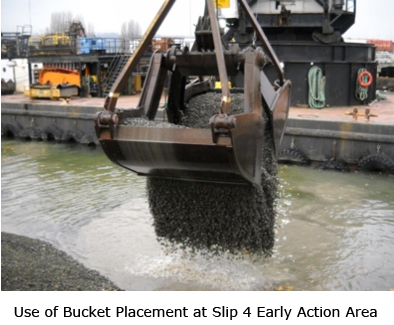|
The specific GAC particle specification of medium-to-coarse size range (U.S. Sieve 8x30 mesh size) was determined not based upon PCB sequestration, but on ease of blending and other materials handling factors. The specifications did identify the need to pre-wet the filter material to reduce flotation of the GAC, and to contain all floatable material within the capping area. The filter material was placed with a minimum of 12 in. thick, with a 6-in overplacement allowance of the overall filter layer. The Removal Action Work Plan, Completion Report, and post-placement monitoring reports may be found at EPA's Slip 4 Early Action Area web page
On the Upper Spokane River in Washington State a multi-layer PCB containment cap was placed using a barge-mounted excavator. The cap consisted of three-layers: a course-grained granular bituminous coal layer placed on top of the PCB-contaminated sediments (nominal 4"), a sand layer (nominal 6"), and a gravel armor layer placed on top of the sand to provide erosion protection. More information at the Washington Department of Ecology Spokane River Upriver Dam cleanup web page, and in EPA's (2013) Use of Amendments for In Situ Remediation at Superfund Sediment Sites.
A series of pilot plots are being tested on the Lower Duwamish Waterway Superfund Site in Seattle, WA. The following information is adapted from the Narrative Design Report: Enhanced Natural Recovery/Activated Carbon Pilot Study, Lower Duwamish Waterway. This pilot project adapted an unconventional approach. Relatively large particles of AC in the range of fine sand (200 microns) to course sand (1,000 microns) were pre-mixed with a medium sand, or gravelly sand1 . That engineering specification was to achieve approximately 4 percent mixed AC by weight. To achieve the specified concentration, approximately 80 pounds of the course AC was mixed with 1 ton of the sand/gravelly sand. The blended material was loaded onto a water-tight barge and presoaked by flooding the barge for a minimum of 12 hours before material placement. Placement of the material was done using using a fixed-arm excavator equipped with a clamshell bucket.
1 Carbonaceous materials with particle diameters of 75 to 300 µm have been found to be most efficient in immobilizing hydrophobic organic contaminants (see online review by D. Kupryianchyk). Significant reduction of PAH pore water concentrations has been obtained after amendment of contaminated sediments using PAC with particle sizes of 15 to 149 µm. No substantial decrease in aqueous PCB concentrations was observed in experiments with granular carbon (particle diameter 420-1700 µm) after 1 month (Zimmerman et al 2009). Commercial mixtures of AC for sediment remediation have particle sizes less than 74 microns (SediMite™) or 44 microns (AquaGate+PAC™)
|



